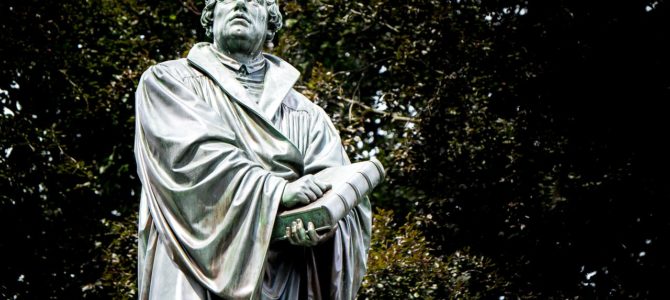
Millions are celebrating one young Augustinian monk’s consequential actions on this year’s 500th anniversary of the Reformation. Even those with no interest in the history of Christianity often know the story of the great Martin Luther and his revolutionary doings on October 31, 1517. Luther’s great protestant hammer detonated a bomb as it drove a nail into the rugged wooden door of Wittenberg’s main cathedral.
It was as if he were driving a spike right into the heart of a terribly corrupt religious system. Second only to the cross of Christ, this action divides Western history into before and after.
The results of this theology professor’s world-changing action are beyond dispute. What actually happened on what is celebrated as Reformation Day, however, is highly questionable. Simply put, it’s unlikely the door episode ever happened. It certainly didn’t happen as portrayed in popular history and classic paintings.
A serious new history, published this anniversary year by Richard Rex, professor of reformation history at Cambridge University, explains that “Bizarrely, there is almost no reliable evidence for this well-known story. There is no credible evidence that Luther actually went and nailed them to the church door that day, and every reason to believe he did not.”
In case one think Rex’s take is simply a revisionist version by a troublesome secularist, evangelical Eric Metaxas parallels Rex’s take precisely in his important new book on Luther. Nearly all serious Luther historians agree on this. The only posting Luther did that day was of two private letters to two bishops under whose authority he stood. Both were dated October 31, 1517. He went to bed that night never having taken up a hammer nor approached any church door with a document and nail.
What Was Inside Those Envelopes
These two envelopes contained his 95 theses and a very personal cover letter, warning the bishops of the abuse of indulgences by the perversely extravagant proto-television evangelist Johann Tetzel. Luther tells us how all this shook out, nicely relayed in a 2015 article in the journal Lutheran Quarterly.
Prior to that All Saint’s Day Eve, Luther told his readers, “I began to dissuade the people, urging that they not listen to the clamors of the indulgence hawkers and that they had better things to do.” Elsewhere he explained, “I began to preach very gently that one could probably do something better and more reliable than purchasing indulgences.” He was not full of thunder but simply being a dutiful pastor to the flock.
“Soon afterwards,” Luther recalled, “I wrote two letters, one to Albrecht the archbishop of Mainz … the other to … Jerome [Scultetus] the Bishop of Brandenburg.” Elsewhere he relayed, “I wrote a letter with the Theses to the bishop of Magdeburg [Albrecht], admonishing him to stop Tetzel and prevent this stupid thing from being preached, lest it might give rise to some unpleasantness.” He had every belief they would put an end to the problem.
Luther was merely following the chain of command over him with his concerns about Tetzel’s antics. In the parlance of today, he saw something and said something. Most importantly, he did so, not with a shred of boldness or indignation, but a jumbo helping of timidity. His letter to Albrecht was riddled with lap-dog praises, greeting Albrecht as my “most reverend Father … worthy of reverence, fear, and most gracious,” and Luther’s “Most Illustrious Prince.”
Luther contrasts himself mightily as “I, the dregs of humanity.” He meekly asks to be spared for having “so much boldness that I have dared to think of a letter to the height of your Sublimity,” and that the good archbishop might “deign to cast an eye upon one speck of dust, and for the sake of your pontifical clemency to heed my prayer.” Metaxas describes the letter as nothing less than “a model of cringing sycophancy.” This evidence shows the October 31 Luther as a purring kitten, while legend has him a roaring lion.
Attempts to Shush Him Up Later Awoke that Roaring Lion
His reformation spirit arose sometime later, and not in one historical incidence. It evolved over the coming weeks. Luther’s warning of Tetzel’s abuses was of no use. The scheme was greater than he had imagined, with Albrecht on the take, splitting the proceeds with the pope after giving Tetzel his hawker’s fee. Thus, Luther’s letters went unanswered, but Jerome did advise him to not rock the boat.
If his theses were ever posted publicly, it was likely due to being dissed by his authorities, which would have happened sometime later. It was never his original intention to make them public, but later he figured that was the logical next step. By Luther’s own telling, he was not an angry revolutionary, but merely trying to be a good son of the Catholic Church. No serious Luther scholars support the angry young hammer-wielding Reformation Day prophet scenario. It is pure myth. No single reforming action took place on October 31, 1517. He did not become a “protestant” on that day, although that certainly came later.
Nearly none of the infamous details of this mythical Wittenberg door tale are true, either. The document? If it happened at all, the posting would simply have been proposal for a theological debate among his peers on indulgences. It was certainly not calling for a revolution. Such invitations for debate were everyday business for professors and nothing worth noting in themselves. To use imagery from basketball, this would have merely been his call for an intramural pick-up game. The debate never happened. No one responded to the invite. This speaks to either the never-posted angle or that it didn’t cause any quake at the time if it had been posted. Curious indeed.
There Are Other Discrepancies with the Story
The famous door? This was not an instance of publicly speaking truth to power by taking his case directly to the main church in town for all to see. Various notices of general interest to the townspeople were posted on a church’s front door. That door served as the community bulletin board, as everyone passed them at least weekly.
These academic invitations also would not have been posted to only one door, the great Cathedral of Wittenberg. It was university policy that such invitations be posted on the doors of every church in the town of Wittenberg, which boasted at least six or more. The posting was not an event, but a mere administrative task.
What about the hammer and nail? The person posting the document was most likely armed with a brush and pot of glue, or a modest tack at best.
Who posted? This task was unlikely performed by an eminent professor, but likely the church or university custodian. Perhaps one of Luther’s students, but certainly not the good doctor himself.
Luther’s theses did indeed bring great thunder to the world, launching nothing short of a civilization-changing movement. No one disputes this, and it is well worth taking note of this 500th anniversary. However, it was not the sound of a hammer upon a door but the clackity-clacking of a new contraption called a printing press that was the detonation point.
A Mechanical Invention Breeds a Theological Revolution
Luther’s theses were printed and sold, without his knowledge or consent, by enterprising printers, their pamphlets spreading “throughout the whole of Germany inside two weeks” as Luther tells us. His work went totally viral before viral was cool, and Luther had little to do with it. The effects surprised him as much as it does any author today whose work blows up the Internet. Luther himself credited the opportunistic printing and distribution of his theses as “the first, real and fundamental beginnings of the ‘Lutheran uproar.’” Before this point, things were pretty quiet.
Although Luther never mentioned any posting on a door in Wittenberg, his faithful friend Melanchthon is credited with launching this famous scene. He explains that, with theses and hammer in hand, Luther “publically posted them at the Church which is next Wittenberg Castle on the eve of the feast of All Saints in the year 1517.” Melanchthon made this claim some years after Luther’s death, was not an eye-witness to the event, and his telling contrasts with Luther’s own.
What about the content of the 95 theses themselves? Where they an omnibus tour de force against the major theological and ecclesiastical problems with the Catholic Church and a call for salvations by grace alone? Not quite. At this point, his concern was solely with indulgences and the nature of true contrition, although the Lutheran agenda would certainly grow with time. (The theses are well worth reading for all interested in cultural literacy, an easy 95 sentence-long collection of statements.)
Luther Wasn’t a Lutheran, But a Catholic Reformer
Luther’s concerns at this stage did not seem to be so much with the use of indulgences themselves (see theses 28, 41, 44, and 49), but with them being sold in such a carnival-like and manipulative way. They were much more Catholic than most assume and many Reformed believers would be comfortable with. Luther scholar Timothy J. Wengert explains in his analysis of the theses how one contemporary reader complained that they “don’t sound very Lutheran at all.”
Indeed. This is because, at this stage in the game, young Luther didn’t consider himself anything more than a “reformist Catholic,” as one scholar put it in a recent Lutheran Quarterly essay. Most readers are also surprised to find the great protestant clearly accepts purgatory and the authority of the pope in his theses. This all changed soon enough. Luther’s boldness grew later the following year, starting his metamorphosis from friendly reformer to a prophetic protester. He certainly didn’t become a “Protestant,” much less a “Lutheran,” on All Saints Eve of 1517. If anything, that day was actually Moving-Toward-Reformation Day.
Why make a point of all this? Of course, none of the popular myths concerning Luther take anything away from the singular influence the man, not only on Christian faith and practice, but on nearly every other sphere of human culture: politics, economics and industry, education, distribution of the printed word, art, the status of women, and the nature and significance of marriage and the family, just to name a few. It’s simply impossible to construct a definitive list of his work’s total influence upon the world.
But the Reformation’s 500th anniversary is more faithfully honored when we replace the myths surrounding it with the facts told by the man himself.









